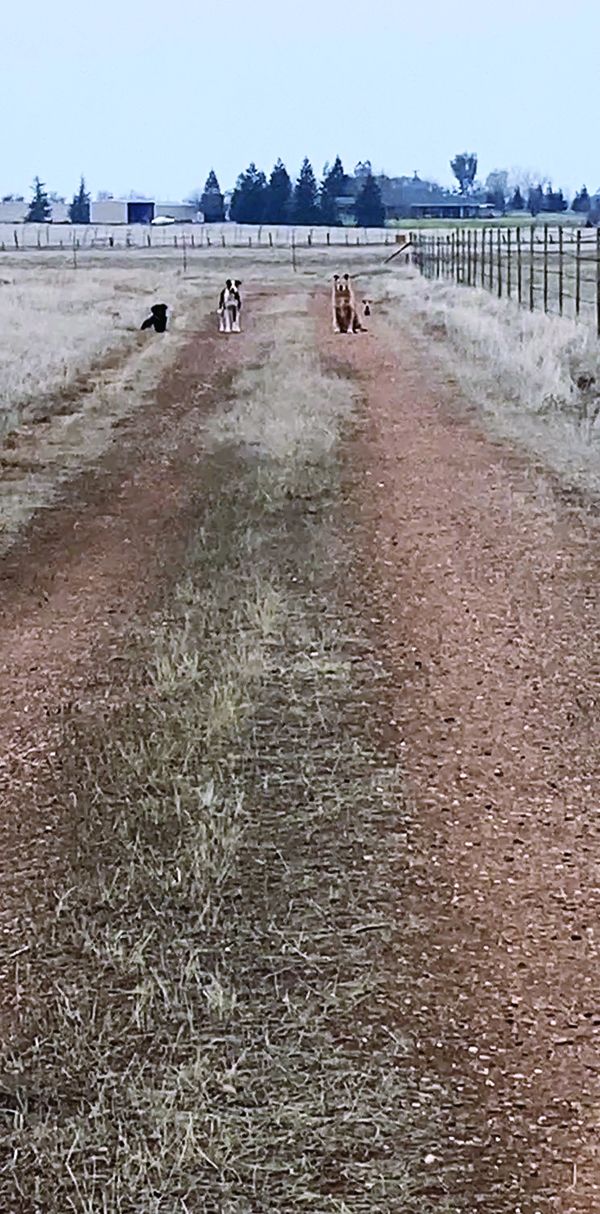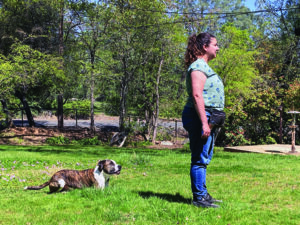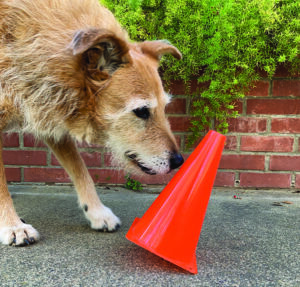
Basic good manners training (sit, down, come, etc.) is vitally important to help your canine family member learn how to survive in a world full of humans. However, training shouldn’t stop there; it’s just as important to continue training well beyond the basics.
Our second-level class here at Peaceable Paws is called “Beyond Good Manners,” and after that our students go on to “Super Dog” classes. In these advanced courses, we solidify basic-level skills, generalize them to more real-life applications, and introduce new training challenges for our dog-human teams to master. The addition of these skills improves communication and relationship between dogs and their humans, strengthens the reliability of the dogs’ responses to cues both at home and in public, and helps them to become better canine citizens.
Here are some of our favorite “Beyond” behaviors:
* DISTANCE WORK. In basic training we generally teach our dogs to respond to our cues when they are right in front of us (except for “Come” of course!). As a result, many dogs think “Down,” for example, means “Lie down at my human’s feet.” If they are across the room and we ask them to lie down, they come running over and drop to the floor right in front of us. Ideally, however, we might want “Down” to mean “Drop to the ground wherever you are when I give you the cue to lie down.”
This is surprisingly easy to teach if your dog already has a solid “verbal down” – that is if he lies down quickly when you give the verbal cue without having to use a treat, hand signal, or any additional prompts. If not, go back to square one and work on that! (See “The Allure of the Lure, July 2018.) Here’s how to teach a Distance Down:
1. Start with your dog sitting in front of you. Cue the “Down” (just to warm up), click or use your marker word, and treat.
2. With your dog sitting in front of you, tell her to wait or stay and take a half-step back. Cue the “Down,” then mark, return to her and deliver the treat. If at any time during this protocol your dog doesn’t lie down when you give the cue, return to where she is sitting and prompt, mark, and treat. If she starts to get up to come to you, remind her to wait or stay.
3. Tell her to wait or stay, take a half-step back, and without asking her to “Down,” mark, return, and treat. If you ask her to “Down” every time you step back, she will start to anticipate your cue and will being lying down before you ask her to. She will think you stepping away is the cue to lie down.
4. Gradually increase distance – a full step, two steps, three steps, etc., remembering to intersperse frequent repetitions in which you return without asking her to lie down, until she will lie down on your verbal cue from any distance. Also release her from the wait or stay frequently so she doesn’t have to stay in one place for too long a time without breaks!
You can use the same process for any other cues you want your dog to respond to from a distance. Start with her in front of or next to you, ask her to wait or stay, and gradually increase the distance from which you cue her for the behavior.

*BLIND WORK. We’re not talking about vision-impaired dogs here, but rather about having your dog respond to cues even if you aren’t looking at each other. Again, you have probably taught your dog to respond to your cues when you are facing each other. But what if your back is turned, or she is facing away from you? What if you are in another room? A well-trained dog will respond to those cues even if you aren’t making eye contact. Here’s how:
1. Have your dog sitting in front of you. Tell her to wait or stay and turn your back to her. Cue her to “Down.” If she lies down, mark, turn around to face her, and feed her a treat. (Since you cannot see if she lies down, you will either need an assistant in front of you who nods or shakes their head to tell you if she did or did not lie down, or you can do it in front of a mirror so you can see if she responded to your cue.) If she does not lie down, turn around, cue again, then mark and treat when she does it.
2. Again, turn around without cueing the down sometimes. As with the Distance Down, intersperse several repetitions in which you turn your back, mark, turn around and treat without cueing the down, so she doesn’t come to think turning your back is the cue to lie down.
3. Repeat Step 1 until she consistently lies down on cue with your back turned. If she seems to be having trouble understanding the concept, try cueing the down from a quarter turn so you are standing sideways to her, and gradually increase the degree of the turn over the course of multiple repetitions until she can do it reliably with your back turned.
4. Now add distance. Combine the Distance Down with the Blind Down for more real-life versatility.
5. Get help. Finally, for an out-of-sight Blind Down, either use a mirror so you can watch your dog, or work with a partner who can tell you if she responds.
Have your dog sit, tell her to wait or stay, and walk out of the room. Then cue her to “Down.” If she does, mark, return, and treat. If she does not, return, cue again, mark, and treat. Then try again. Remember to intersperse lots of “not-down” trials for every “Down” that you cue!
Teaching a combination of the Blind Down and Distance Down also gives you a valuable Emergency Down with which you can stop your dog in her tracks if she is headed toward danger.
* COME PAST DISTRACTIONS. When you have taught your dog to come to you in non-distracting environments, it’s time to up the ante. (See “Rocket Recalls,” September 2012.) You can do this by continuing to practice your Run Away (Let’s Party!) recall while gradually introducing distractions.
You can make it even better by introducing the Premack Principle, in which your dog learns that the way to get permission to investigate something she wants is to come to you first. The Premack Principle says that you can use a higher value/more likely behavior to reinforce a lower value/less likely behavior. This is also called “Grandma’s Law” – you have to eat your vegetables before you can have your dessert.
You can teach this informally in everyday situations. When you are out walking with your dog on leash and you can see that she wants to go investigate something, occasionally (not every time!) happily call her to you, and when she gets to you give a cheerful, “Okay go!” cue and run with her to the object of her attention.
You can also teach her the Premack concept more formally as follows:
1. Have a helper stand in the center of the room. Tell your dog to wait or stay and walk across the room past the person.
2. Cheerfully call your dog and run away from her. When she runs past the helper to get to you, pick up her leash, say “Let’s go see (person’s name)!” and quickly run with her back to the person, who then greets the dog with excitement.
3. Increase the distractions. As she begins to understand that coming to you makes the good stuff accessible, gradually increase the difficulty of distraction – have the helper sit on the floor, lie on the floor, hold treats, puts a plate of food on the floor (with a bowl to cover it if needed).
This extremely useful protocol teaches your dog to come to you in order to “win” the reward of running to play with another dog, going to visit a person with treats, sniffing a tempting pee spot, or chasing a squirrel.

* TARGETING TO OBJECTS. In basic training, we teach our dogs to touch their nose to our hand in a behavior known as “targeting.” If your dog loves the “touch” behavior, you can use the hand-target as an alternative to your recall cue, as she must come to you in order to target to (touch) your hand.
You can build on this behavior by teaching her to nose-target to a variety of other objects, which you can then use to send her away from you to an object or location, and as part of your repertoire of cognition games. Here’s how:
1. Start with your dog facing you, standing or sitting, and ask her to “Wait.” Hold the object you want her to touch in your hand and say its designated “name” out loud (Stuffy, Ball, Squeaky, or whatever you want to call it). If she starts to move toward it, tell her to “Wait” again. You want her to not touch it until you give your “Touch” cue.
2. Say “Touch,” and present the item several inches away from her (at first), at nose level or slightly below. When she touches the item, mark and treat. She may hesitate and be a bit confused at first since she was previously accustomed to touching your hand. Make it easy for her to reach and touch the item.
3. Add distance. When she reliably touches the named object with the two-word cue (“Squeaky! Touch!), start presenting it in your hand at a greater distance. Mark and treat every success.
4. Separate yourself from the item. Now place the object on a chair or on the floor, with your hand behind it, and ask for the touch. Mark and treat each successful touch!
5. Increase distance. Gradually move your hand farther away from the object over several repetitions, until she no longer needs your hand there to respond reliably to your “Object! Touch!” cue.
6. Vary the starting point. Gradually move away from the object with your dog and vary your starting point before asking for the touch, until you can send her away from you to touch the object from increasing distances.
7. Vary the location of the item. Next, randomly place the object in different locations so you can send her to touch it from various distances at various locations from different starting points.
8. Finally, generalize. Repeat the sequence with different objects at new locations (outdoors, on walks, at friends’ houses, etc.).
For a useful application of this behavior, you can teach her to target to the lid from a cottage cheese or yogurt tub; tape the lid to a wall, send her away from you to touch it, and then cue your Distance Down.
For more cognition games where you can use this behavior, see “Are Canines Cognitive?” October 2017.
* GENERALIZE A “WAIT.” We teach a basic “Wait” behavior using the dog’s food bowl, which instills polite behavior at mealtimes.
But “Wait” has many more useful real-life applications, including “Wait at the door until I tell you that you can go out.” This an important life-saving behavior, as it helps prevent door-darting and keeps your dog safely in your car, even with doors open, until you tell her she can get out. You can do this with your dog sitting or standing – whichever you prefer (I prefer sitting, as they are more “parked” in a sit):
1. At the door, tell your dog “Wait” in a cheerful tone of voice. Reach toward the doorknob but don’t touch it. If your dog starts to move, remind her to wait, then reach again, but not as close to the knob. Mark and treat when she holds that position for the several seconds that it takes to reach for the door and withdraw your hand.
2. Get closer to turning the doorknob. Do multiple repetitions, gradually reaching closer to the knob, marking and treating each time your dog holds the wait, until you can touch and rattle the knob without your dog getting up.
3. Begin to open the door very slightly. If your dog starts to move to go out, remind her to wait and close the door (be sure your dog won’t get caught by the door!). Repeat your “Wait” cue and try opening the door again. Begin opening the door a little bit, then gradually open it more and more. Mark and treat each repetition. Frequently release her from the “Wait” with your release cue (“Free!” “Break,” or whatever) as you do multiple repetitions.
4. Practice until it’s reliable. Continue cueing your dog to wait and opening the door until you’re able to open it completely and your dog reliably waits.
5. Have her wait while you go out and then right back in. Now cue her to “Wait!” while you step outside the door and return.
6. Mix it up. Once she’s able to wait reliably as you walk out the door, sometimes say your release word after you walk out and let her go out with you, sometimes close the door while you are inside with her, and sometimes close the door with her still inside while you are outside. (You can call your release cue through the door when you are outside since you won’t expect her to “Wait” when you are gone and the door closing when you are outside will eventually become an automatic release cue.)
7. Cue your dog to “Wait” every time the door opens. Consistency is the key to helping your dog learn quickly! This behavior will easily generalize to other situations, such as waiting when the car door opens, when she’s getting too far away from you on an off-leash hike, and if you want her to pause when she’s approaching someone or something.
*“TEMPTATION ALLEY.” Our basic “Leave It!” teaches your dog to ignore something in proximity to you, starting with a forbidden treat you place under your foot to prevent her from being able to eat it. In our world, “Leave it!” means she never gets to have that treat, at least not in that location. Once your dog has mastered the basic “Leave It,” she is ready for Temptation Alley, which generalizes the behavior to the real world:
1. Set up the alley of alluring items. Place a half-dozen or so items that your dog likes in a line, about four to six feet apart. The items should range from slightly tempting to seriously alluring – a box, a ball, a stuffed toy, a chew-treat, a piece of chicken, and so on. The goal is to walk alongside the line of items in a parallel path, about four feet away from the items.
2. Start walking parallel to the row of items but don’t let your dog reach any of them. With your dog on leash, start walking along the line, in a parallel path about four feet away from the items. Your leash should be short enough so your dog can’t reach the items. It’s critical to have a good grip and not allow yourself to have “bungee cord arms,” so your dog does not reach and get any of the items. (If she does, she unintentionally has been reinforced for pulling toward something you didn’t want her to have – and she will likely pull harder or more suddenly next time!)
3. As soon as she glances at one of the objects, cheerfully tell her to “Leave it!” I want to emphasize the “cheerful” part of this. We’re not trying to sternly warn the dog or intimidate her; we’re trying to teach her a cue for a specific behavior.
If she looks away from the item, mark the behavior (click or “Yes!”) and give her a treat and keep walking. Repeat for each of the objects she looks at (and away from).
4. If she continues to look at any of the items after your “Leave it!” cue, or tries to pull toward an item, just stop, and, keeping a firm grip on the leash and no stretchy arms, stand still and wait until she eventually looks away; do not repeat your cue, or use any “no reward” markers or admonishments such as “Eh eh!” or “No!” When she looks away from the item, mark, treat and continue with Step 3 until you have passed the whole row of items. Then turn around and do it again.
5. Move closer to the line and repeat. When she will reliably pass all the items, either not looking at them or immediately looking away when you give the cue, you can walk in a line that is closer to the Alley and repeat.
It’s easy to see how useful this behavior is in real life. The aromatic bag of fast-food remains on the sidewalk, the tempting pile of kitty poop in the flower bed, the cookie in the hand of the toddler – the applications are endless! When your dog is a star at Temptation Alley, occasionally use your “Leave It” cue on your walks until she can do it anywhere, anytime, for anything.
For more about teaching your dog to “Leave It,” see “Leaving for Good,” June 2018.

ADVANCED TRAINING
These are just a few of the many Beyond Good Manners that will serve you and your dog well in daily life. If you’re not already working with one, search out a good, force-free trainer in your community who can help you and your dog have fun as you journey together through a lifetime of learning together.




